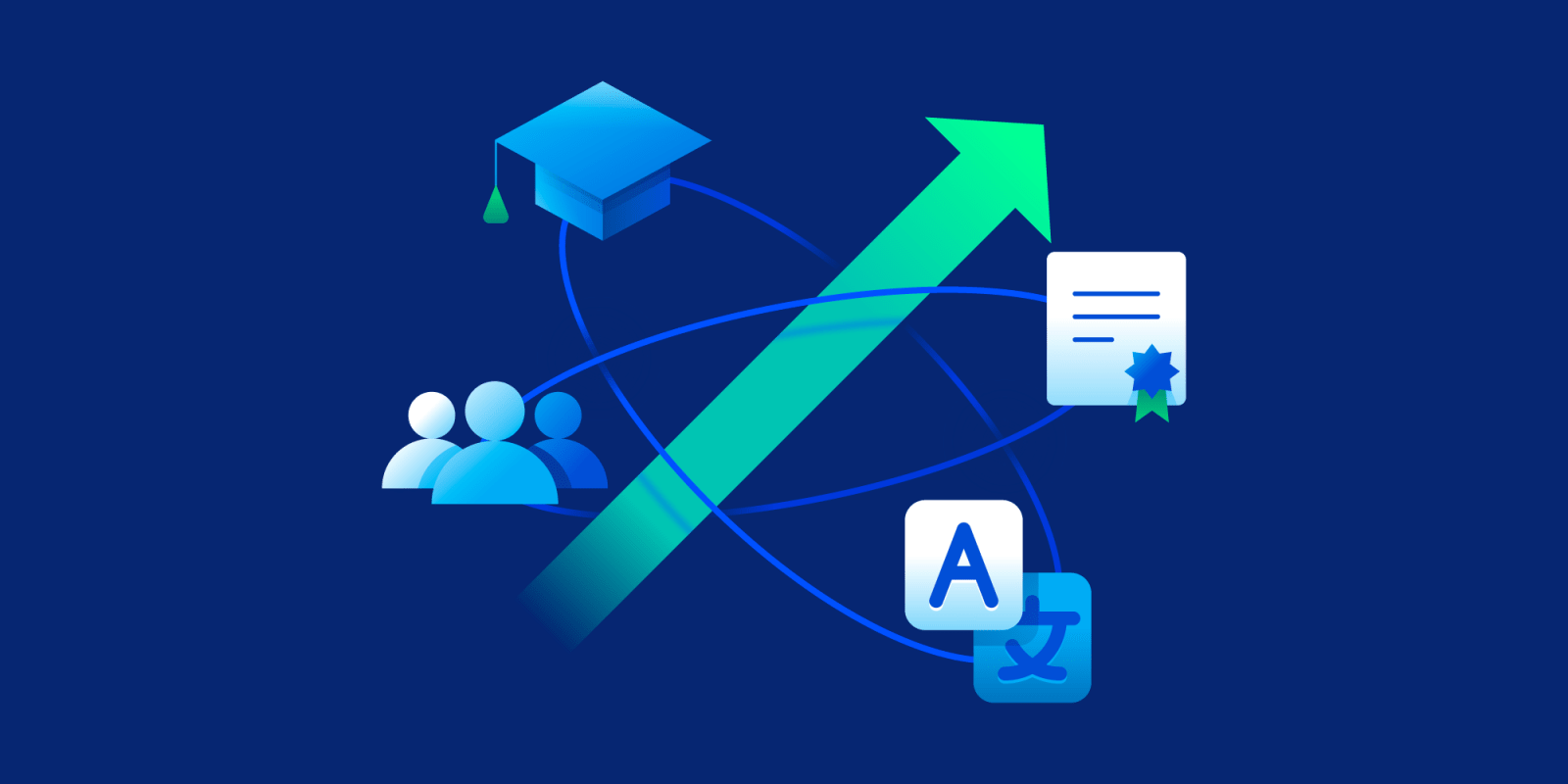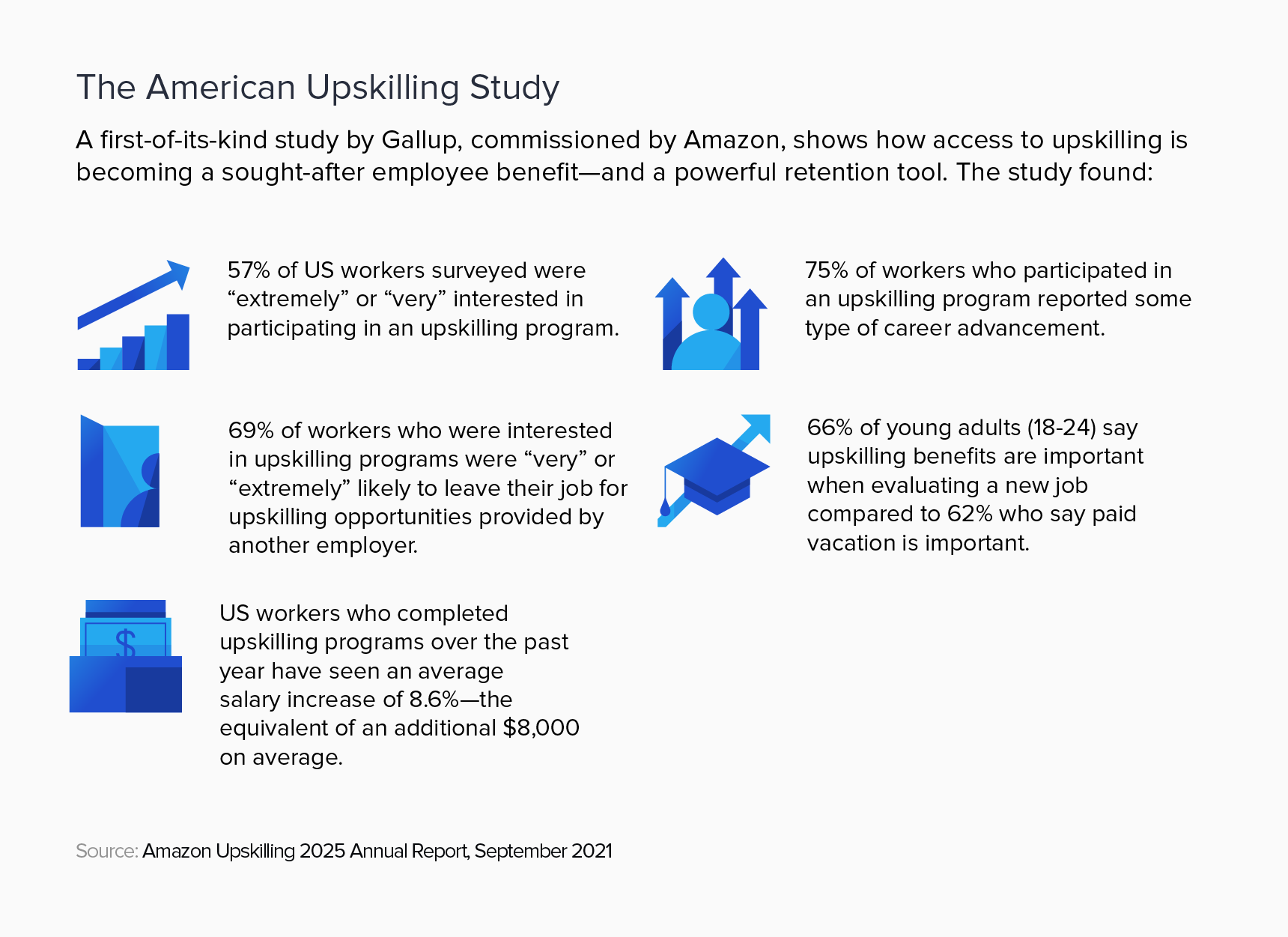How the Amazon Upskilling Program Is Retaining Top Talent
authors are vetted experts in their fields and write on topics in which they are extremely knowledgeable. All of our content is peer reviewed and validated by world-class professionals.

As the second-largest employer in the US, Amazon has a successful approach to creating good jobs: Offering competitive wages (Amazon’s minimum wage is more than two times the federal wage), providing robust benefits, including paid parental leave and college tuition for our full-time employees from day one; and giving employees the opportunity to add skills to experience through a variety of Amazon training programs.
Access to upskilling has increased in importance to both candidates and employees since the war for talent became increasingly competitive. In my role as VP of Workforce Development, I recognize that an Amazon training program can advance our employees’ education and skills, helping them progress into in-demand career paths and enabling us to accelerate business growth, create a stronger workforce culture, and attract talent. Talent upskilling is a good retention strategy for us. When we help people along their desired career path, they are more likely to join, stay with our team, or pursue their passions.
Why Should You Utilize Talent Upskilling?
To measure the importance of upskilling in today’s workforce, we commissioned a comprehensive study with Gallup in 2021. The results underscored that such programs are a key driver of American workers’ employment decisions:
- Sixty-five percent of American workers said the opportunity to participate in a talent upskilling program was extremely or very important in their decision to take a new job.
- Sixty-one percent cited such programs as an important factor when weighing whether or not to stay in their current role.
- Forty-eight percent of workers said they would switch to a new job if offered skills training.
The Gallup research found that upskilling is associated with an 8.6% increase in annual income—about $8,000 per year on average—as well as a higher standard of living. Thirty percent of workers said they were able to move into higher-paying jobs after gaining new skills, and 39% advanced in their current positions. Plus, 71% of workers who augmented their skills said it led to greater job satisfaction.
Among young adults, upskilling was cited as the third most important benefit behind health insurance and disability coverage. If applied on a larger scale, upskilling could significantly boost economic growth and reduce wage inequality, noted Gallup’s Chief Economist Jonathan Rothwell.

Additional studies have underscored the importance of talent upskilling programs in today’s workforce:
- According to a study by Monster, at the end of 2020, one-third of US employers said their workforce skills gap had increased over the previous year, while 80% reported difficulty filling openings because of that gap.
- Gartner research from 2021 found that 58% of the workforce needs new skills to do their jobs.
- Nearly 60% of 1,260 learning and development professionals identified upskilling and reskilling as their top priority, according to the 2022 Workplace Learning Report from LinkedIn Learning.
- A survey conducted by West Monroe Partners and released in 2018 found that 56% of 432 HR professionals and 1,000 US employees surveyed described their organizations’ skills gap as moderate to severe, while only 6% said there was no gap at all.
How Does Amazon Train Their Employees?
Our venture into upskilling began in 2012 with the launch of our Career Choice program, which enables our part-time and full-time hourly employees to receive training in higher-paying, in-demand fields to pursue a career path in or outside of Amazon. Employees can take classes online, in person at a local campus, or on site in one of the more than 110 Career Choice classrooms in fulfillment centers in 37 states. To date, Career Choice has helped provide education for more than 50,000 Amazon employees.
More than half of our Career Choice participants have told us they would like to utilize the education to advance within Amazon, while many employees focus on career paths not offered by Amazon, such as nursing and medical assistants. We offer them this choice.
In 2019, we announced Upskilling 2025, a $700 million commitment to train 100,000 US employees and help them transition into highly skilled technical and nontechnical roles both in and outside of Amazon. Then, in September 2021, we increased our commitment to $1.2 billion and vowed to help more than 300,000 of our employees to secure the skills and experience they need to pursue high-growth, in-demand jobs by 2025.
As part of this program expansion, in January 2022, our 750,000 hourly US operations employees became eligible for fully funded college tuition, including classes, books, and fees. And in March 2022, we announced our partnership with more than 180 education providers, including several US colleges and nonprofit online educators. Now, after just 90 days of employment—and for every year they work at Amazon—employees have the opportunity to receive a fully funded education. They are eligible to choose from four national nonprofit universities and dozens of local colleges and universities. They can also work with industry education partners that provide certifications, English language proficiency, college preparatory courses, and high school/GED completion programs.
Our Upskilling 2025 pledge is made up of nine Amazon training programs for employees: Amazon Technical Academy, Machine Learning University, Career Choice, Amazon Technical Apprenticeships, AWS Training and Certification, AWS Grow Our Own Talent, Mechatronics and Robotics Apprenticeship, Surge2IT, and the User Experience Design and Research (UXDR) Apprenticeship. Since September 2021, more than 70,000 Amazon employees have taken advantage of one of our Upskilling 2025 programs.
Employee Successes
The numbers clearly support investing in skills development, but these employee stories show the real impact:
As a single mom of four who had spent 10 years in the US Army, Erica Bozeman was seeking a better work-life balance. A recruiter told her about the Amazon Technical Apprenticeship program, which offers paid technical training to former military members. A few weeks after applying, Erica started a technician apprenticeship program with Amazon. Today, she works four days a week as a data technician, with plans to open her own business in the future.
After serving in the US Air Force, Melfi Perez earned a degree in IT and began her job search. After applying for the Amazon Technical Apprenticeship program, she traveled to Seattle to attend the company’s technical boot camp, then to California for on-the-job training. Melfi is now a full-time software engineer, working with knowledge engineers to code Alexa’s responses. “This program opens the door for people to get paid to learn and figure out if they enjoy a field,” she says. “And if they do really well, they’ll have a job.”
Colleen Woods started out delivering orders from one of our Dallas fulfillment centers. After three years, she decided to pursue an education in aerospace manufacturing through Career Choice. Amazon covered most of the cost. Today, Colleen has a higher-paying job with a Dallas aerospace company.

Tips for Starting an Upskilling Program
Although there’s no such thing as a one-size-fits-all program, we’ve learned some general lessons as we’ve scaled our upskilling programs that other organizations can apply.
Embrace Partnerships
As we got started, we quickly realized the importance of working across the entire ecosystem—educators, employers, and catalytic agencies—to link education to employment.
In particular, we work closely with community colleges; they’re a great resource for finding out which jobs are in demand locally as well as which employers are seeking skilled talent.
We also work with industry associations that identify talent gaps. For example, we partnered with the US Department of Labor (DOL) to register our apprenticeships, which are internally and externally developed.
Meet Employees Where They Are
The vast majority of employees in an Amazon upskilling program are adult learners who are already part of the workforce. Many of them have family obligations—and a lot of people don't go back to school full-time or pursue additional training because they can’t afford the expense or the time-off required.
We fund the education or training and work with local community colleges or training experts to either bring the training into our facilities or make it available virtually, with flexible hours to accommodate work schedules and family obligations.
Don’t Be Afraid to Experiment
In 2016, we started the Amazon Technical Apprenticeship program with one specialty in cloud computing at one site. Since then, we have scaled to nine DOL-registered apprenticeship programs. We have also added a virtual option as an alternative to the classroom-based training, for people who don’t want to relocate to a site where training is offered. My advice is to start small, iterate pilots, and then scale what works.
Help Employees Pursue Their Passions
We work hard to ensure that all of our employees have a path to success—but we also want employees to pursue whatever career path is right for them and their families. An employee who completed our Career Choice program and then left to become a medical assistant, for example, was ultimately successful in her career progression and found her true passion in healthcare.
Upskilling has been an effective strategy for Amazon. The data we’ve collected tells us that employees are happier and more fulfilled when their employer offers more upskilling options—whether that leads to another role within Amazon or a new role outside the company.
I’m excited to continue unlocking opportunities and transforming employees’ lives by helping them grow their knowledge, skills, and experience through the Amazon training program. Our work helps us pursue our mission of being Earth’s best employer, and helping our employees find a job that helps them build a career. Companies that help people build new skills can improve employees’ satisfaction and retention rates, and demonstrate a commitment to an engaged, productive, and fulfilled workforce for the future.
